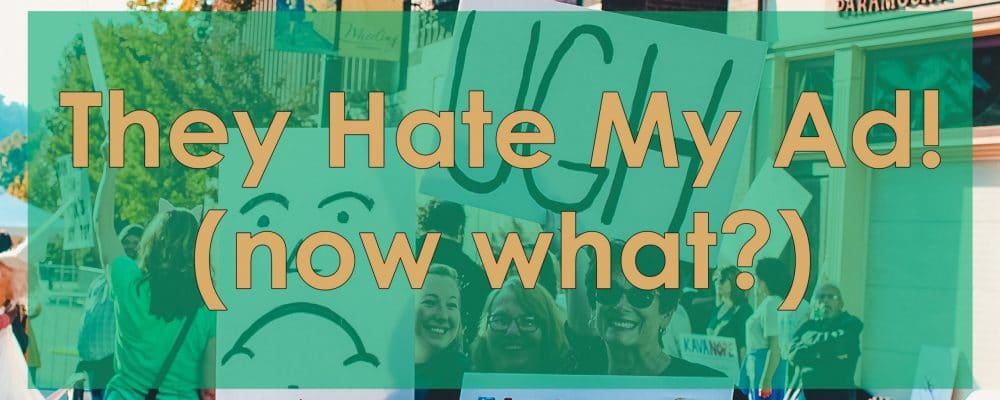Listen To The Podcast:
Good! (usually)
Rough edges, unexpected twists, and raw, unfiltered spokespersons.
Some people will love it, while others will let you know exactly how they feel.
People are more likely to complain than praise. According to research collected by Inc. Magazine, only one in ten are likely to give you a compliment. One could, perhaps, extrapolate that it took nine happy people before you found one buzzkill.
Now, I don’t subscribe to the notion that “hey, they remembered you…and that’s all that matters.” It’s very easy to be outrageous and “get remembered.” The job of your ad is to “get remembered” and sell some stuff.
If you’re doing it right and your ad stands out from the rest, detractors are sure to follow.
(If you want to hear some whopper complaints I’ve received for just one company, watch this video)
To determine if the complaint is warranted, ask yourself:
1: Is your ad true?
If your ad is portraying your company is it is (passionate, quirky, resolute, playful)…Don’t change a thing.
2: Is it you?
Does the ad portray your values? Does it demonstrate what you stand for? …and stand against? People who take a stand and are confident in their abilities make milquetoast people shudder. It’s not your job to make dullards comfortable. Don’t change a thing.
BUT…
3: Is it decent?
Are you taking an unnecessary swing at someone, something, or some movement? Save it. It’s hard enough to get people to buy your product. They’re not going to buy into your political platform, too.*

Magnets both attract and repel. It’s what magnets to. If you’re not repellin’, you’re probably not attractin’.
When you’ve successfully caught attention, it’s inevitable you’ll ruffle those who didn’t want their attention caught.
If this sounds like a delicate balancing act…it can be.
Professional construction workers using powerful tools can build The Burj Khalifa.
Amateurs will cut their leg off.
“I hate your commercial” usually means you’re on the right track.
Usually.

*There’s always an exception, and Nike’s Colin Kaepernick ad is that exception. They took a specific stand, and undeniably both repelled and attracted customers. They did this with a precise understanding of who their customers are…and who they are not. This was not a huge gamble, as pundits suggested. After decades of quantitative and qualitative research, the ad was 100% on-brand for Nike. The customers they sacrificed were eclipsed by the profound number of customers they gained. Was it a “bold stance,” or a “calculated use of Nike’s customers?”
Political wonks say will one thing. Marketers know exactly what it was.
- Marketing Has a Physics Problem - December 3, 2025
- AI is OK - August 14, 2025
- Emotion in Advertising Equals Dollars in Business - December 3, 2024

